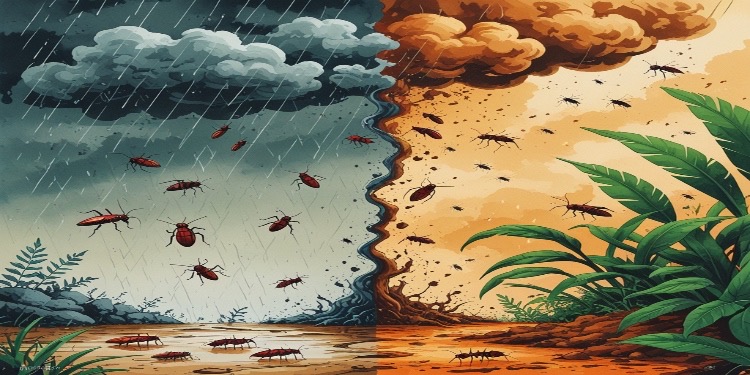You might not notice it right away, but pests are weather watchers. Just like humans respond to shifts in temperature and humidity, insects and rodents change their behavior in response to the weather—only their response often involves invading your home.
From heatwaves and droughts to heavy rainfall and sudden cold snaps, weather plays a powerful role in pest patterns. Understanding how and why pests react to different conditions can help homeowners prepare proactively—and know when it’s time to call in professional pest control services.
Let’s break down how seasonal weather events influence pest activity, one natural occurrence at a time.
1. Heavy Rainfall: When Water Forces Pests Indoors
While rain may be great for your lawn, it can drive pests into your home. Burrowing insects and rodents like ants, earwigs, cockroaches, and mice tend to flee flooded nests or waterlogged soil by seeking higher ground—which often leads them into basements, garages, or crawl spaces.
What Happens:
- Ant colonies are disturbed and relocate toward dry foundations
- Cockroaches seek warmth and shelter in kitchens and laundry rooms
- Rodents escape saturated tunnels and may enter attics or wall voids
- Termites may swarm shortly after rainfall, signaling new colony formation
Prevention Tips:
- Seal gaps around doors and windows
- Ensure your gutters and downspouts divert water away from the foundation
- Keep crawl spaces and basements dry using dehumidifiers or sump pumps
- Watch for mud tubes or swarmer termites near windows after storms—these are early signs that termite control may be needed
Rain doesn’t just invite pests—it may reveal infestations already in progress by displacing them into visible areas of your home.
2. Heatwaves: Pest Breeding Accelerates
When temperatures rise, many insects enter their peak reproductive cycles. Prolonged heat and humidity can turn minor pest issues into full-blown infestations in a matter of days. This is particularly true for common warm-weather pests such as flies, mosquitoes, ants, and bed bugs.
What Happens:
- Bed bugs multiply rapidly in hot bedrooms or shared spaces
- Fruit flies swarm around produce and trash in warm kitchens
- Ants become more active in search of water and sugary foods
- In some areas, termites intensify wood consumption to sustain growing colonies
Prevention Tips:
- Don’t leave pet food or water bowls out overnight
- Take out garbage daily, especially in summer
- Keep windows screened and avoid propping doors open
- Launder linens frequently to reduce bed bug exposure during heat spikes
Exterminators often experience a surge in calls during extreme heat—especially from homeowners battling ants or indoor fly activity. Agile Pest Control sees heat-related pest issues peak between late June and early September.
3. Cold Snaps: Rodents and Spiders Seek Shelter
Sudden drops in temperature—especially early in fall—often drive outdoor pests indoors. Mice, rats, spiders, and overwintering insects like stink bugs and boxelder bugs look for warm, protected places to spend the colder months.
What Happens:
- Mice and rats find entry through vents, chimneys, and cracks in siding
- Spiders become more active indoors in search of prey and warmth
- Ladybugs and stink bugs gather in attic corners and window sills
- Wasps may attempt to overwinter in sheds, garages, or wall voids
Prevention Tips:
- Inspect insulation and seal utility line gaps with steel wool or foam
- Replace worn-out weather stripping and install door sweeps
- Declutter storage areas to reduce nesting spots
- Clean out gutters before the first frost to deter wasps and ants
While not as fast-moving as summer pests, cold-weather invaders often go unnoticed until they’ve already settled in for the season. It’s important to be proactive, especially if you live near wooded areas or water sources.
4. Droughts: Desperate Pests Search for Water
During dry periods, pests don’t just slow down—they become more determined. Lack of access to natural water sources drives ants, roaches, and even scorpions (in certain regions) into kitchens and bathrooms looking for hydration.
What Happens:
- Ants may appear in bathroom sinks or around pipe seals
- Roaches congregate near dishwashers and refrigerators
- Wasps become aggressive as they search for water in outdoor fountains or pools
- Termite colonies in dry areas may move closer to home foundations where moisture is present
Prevention Tips:
- Fix leaky faucets and dripping pipes immediately
- Don’t leave standing water in pet bowls or potted plant trays
- Clean under and behind appliances where condensation builds up
- Keep mulch and damp soil at least 12 inches from your home’s foundation
Long dry spells don’t eliminate pest risks—they refocus them. If you start seeing pests where water is abundant, it may be time to reassess moisture control around your home.
5. Storms and Wind Events: Pest Disruption and Migration
Strong winds, hail, and storm surges can destroy natural pest habitats, forcing animals and insects to relocate rapidly. After severe weather, pests often migrate long distances to seek new shelter and food sources—sometimes ending up in unfamiliar residential areas.
What Happens:
- Fleas and ticks spread from displaced wildlife to household pets
- Structural damage from storms opens new pest entry points
- Pest migration changes regional patterns, introducing new threats
- Debris piles and downed trees become breeding grounds for insects
Prevention Tips:
- Remove storm debris promptly from yards and gutters
- Check rooflines, vents, and siding for cracks or gaps
- Inspect pets after outdoor activity, especially in wooded or grassy areas
- Dispose of rotting tree limbs and yard waste that may attract termites or rodents
Storms don’t just cause immediate damage—they can set the stage for long-term pest control challenges. If you’ve recently experienced a major weather event, it’s wise to have an inspection performed by a licensed exterminator.
Final Thought: Pests Follow the Forecast
Pests are part of nature—but that doesn’t mean they belong in your home. As seasons shift and weather patterns become more unpredictable, it’s important to recognize how external conditions influence internal pest pressures.
By staying informed and watching for pest patterns tied to rain, heat, drought, or cold, you can act before infestations take root. And when DIY prevention isn’t enough, partnering with experienced pest control professionals like Agile Pest Control ensures that your home remains a safe, pest-free space—rain or shine.












































































